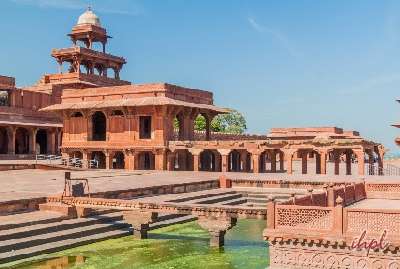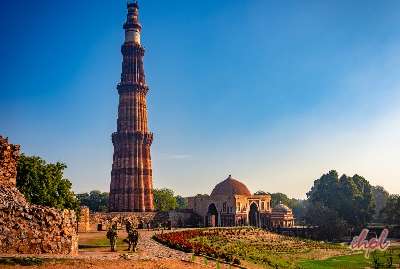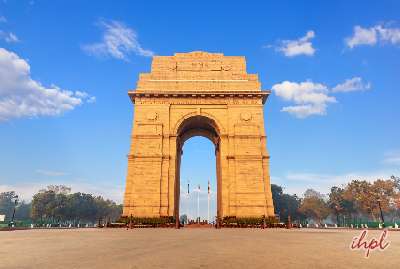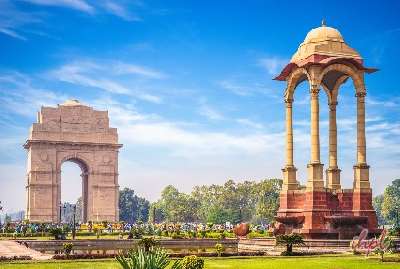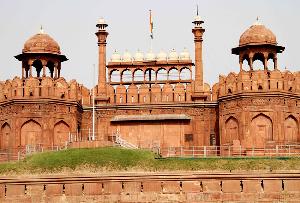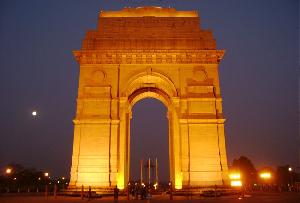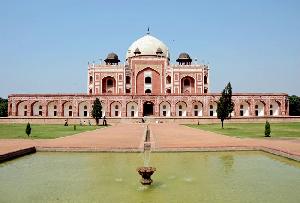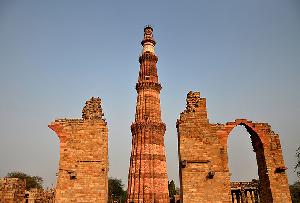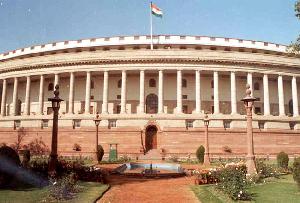Located at the western end of the old street of Chandni Chowk in Delhi, Fatehpuri Masjid was built in 1650 by Mughal emperor Shahjahan’s wife, Fatehpuri Begum. Named after its creator, this red sandstone mosque is a beautiful specimen of the magnificence of Mughal architecture.
During the British rule, troops were stationed in Fathepuri Masjid in 1857 and later on it was confiscated and auctioned. It was at this place that many famous inter-religious debates took place in the past.
Description:
The main mosque is built on a three-and-a-half feet high platform. Its main dome is colossal and is flanked by two towering minarets. The prayer hall has seven arched openings of which the central arch is the highest, with kangaroos and large domes on both sides of it. There are strips of white marble on the arches and domes. The main dome is built of lime mortar and bears black and white strips.
Fatehpuri Masjid has three gates: one is right in front of the Red Fort and the other two are in the north and the south. Khari Baoli is in the north end and Katra Baryan in the south.
The central courtyard is laid with red stones. There are single and double-storied apartments on the sides. There are two verandas, 12 ft. apart, on both sides of the main arch, with kangaroos on their roofs also.
There is a very large tank (hauz) in the courtyard of the mosque. This marble tank is used for ablution. The pulpit inside the mosque is built of marble and has four steps. Rows of red stone pillars stand on both sides of the mosque.
History:
The historical mosque Fatehpuri Masjid in Delhi was built in 1650 by Fatehpuri Begum, one of emperor Shahjahan’s wives. Facing Red Fort, the historical seat of Mughal power, Fatehpuri stands as a silent spectator, witnessing all historical events right from the Mughal and British periods till date.
Fatehpuri Masjid was in a way a rival of the Jama Masjid, the latter built by Shahjahan and the former by his devoted begum, who thought this to be the best way to commemorate herself. The mosque is not one of the best specimens of Mughal architecture because the building materials were of poor quality.
During the Mughal days the mosque housed some beautiful fountains and a huge central tank. But in 1857, after the Mutiny, British troops occupied the mosque and the soldiers left no stone unturned to damage the monument. They carved their names on the beautiful red sandstone walls and held parties inside the monument with liquor flowing in abundance. Moreover, some of them used to even climb the pulpit in a drunken state and preach nonsensical sermons.
Such disorder continued for some time until finally the Masjid was handed back to the trustees. The British had auctioned off the courtyard to Seth Chunna Mal. But at the Delhi Durbar in 1877, that too was handed back to the Muslims in exchange for four villages in Mehrauli. There are a few graves in Fatehpuri Masjid including those of Hazrat Nanoon Shah, Shah Jalal, Mufti Muhammad Mazhar and others.
Annual Events:
Fatehpuri Masjid is a major mosque of Shahjahanabad in Delhi, and is located at the western end of Chandni Chowk, the oldest street of Delhi. Built by one of Shahjahan’s wives, Fatehpuri Masjid is considered a smaller representation of the Jami Mosque scheme. It is one of the important Masjids that bring elegance and grace to the centers of Islamic worship in India.
The mosque has a traditional design with the pillared prayer hall made up of multi-lobed arcades and columns. All Muslim festivals are enthusiastically celebrated in Fatehpuri Masjid. These are the appropriate occasions to visit the Masjid as they offer the unique opportunity to experience the immense faith and love of the devotees. The special Annual Events that take place in the premises are:
Id-ul-Fitr:
Popularly known as the “Festival of the Breaking of the Fast”, Id-ul-Fitr occurs as soon as the new moon appears at the end of the month of fasting, namely Ramadan. The festival is intended to be a festive and joyous occasion. Thousands of devotees gather at Fatehpuri Masjid to celebrate the occasion. Special foods and delicacies are prepared for the day are distributed among friends.
Id-ul-Zuha:
Also called Bakr-Id, Id-ul-Zuha, is a festival of great rejoice. Special prayers and exchange of greetings and gifts mark this auspicious occasion. This festival of sacrifice is celebrated with traditional fervour and gaiety in Fatehpuri Masjid. On this day, special `Dua’ is recited by thousands of devotees for peace and prosperity.
Fast – Facts:
Fatehpuri Masjid, one of the ancient mosques of Shahjahanabad, was built with red sandstone stands on the western end of Chandni Chowk in Delhi and is surmounted by a single dome.
Some fast facts about the Masjid are:
Location:
At the western end of the famous street of Chandni Chowk in old Delhi
How to Reach:
Local buses are available from various points within the city to reach this sacred monument, which is located at the terminal point of Chandni Chowk, the heart of the old Delhi. One can also hire auto-rickshaws and taxis to reach the mosque.
Time to visit: Open on all days
Preferred Timings: Sunrise to sunset
Admission Fee: Free and open to all.
Photography charges: Nil
Nearest Railway Station: Old Delhi Railway Station
Nearest Metro Station: Delhi Main
Functional Metro Station: Delhi Main
Nearest International Airport: Indira Gandhi International Airport
Time required for sightseeing: 30 minutes
Nearby Places to Eat
Some of the nearby places to eat include Karim Hotel, Ghantewala sweet shop, food stalls near Jama Masjid, Paranthewali Gali, Natraj hotel, Chor Bizarre of Broadway Hotel, Daryaganj’s Flora, Peshwari, Moti Mahal Restaurant, Worker’s canteen of Inter-State Bus terminal.
Nearby Shopping Venues
Enjoy the charm of shopping at nearby markets like Chandni Chowk (curios, souvenirs, silver and glass bead jewelry), Nai Sarak (books), Chor bazaar (electronic goods), Daryaganj book market (on Sunday) and Chatta Chowk in Red Fort (traditional and contemporary jewelry and handicrafts)
Nearby Attractions:
An important mosque in Old Delhi is Fatehpuri Masjid, located at the terminal point of the Chandni Chowk. Built in during the Mughal era in 1650, this mosque is a landmark of Delhi that few tourists can miss. Due to its convenient location, Fatehpuri Masjid provides access to a number of major tourist destinations in Delhi. Some of these nearby attractions are:
Jama Masjid
An outstanding symbol of the brilliance of Mughal Architecture, Jama Masjid was built by emperor Shahjahan in 1656. It lies opposite to the Red Fort and is arguably the country’s largest mosque.
Chandni Chowk
Chandni Chowk is a widely known market that lies opposite the Red Fort in Delhi. The area was laid out by Shahjahan’s daughter, Jahanara.This market bustles with activity all through the year.
Salimgarh Fort
Built in 1546 by Salim Shah, son and successor of Sher Shah Suri, Salimgarh Fort was constructed on an island of river Yamuna. It is situated at a distance of about 1 kilometer northeast of Red Fort on the Ring Road after crossing the national memorial. The fort has now been renamed as Swatantrata Senani Smarak (Freedom Fighters’ Memorial) because a memorial for freedom fighters has been developed inside the fort.
Kashmeri Gate
Built by Military Engineer Robert Smith in 1835, the gate is named so because it used led to a pathway to Kashmir. The gate first gained national attention during India’s struugle for freedom from the British regime.
St. James Church
Located ½ km from Kashmeri Gate, at the intersection of Church Road and Lothian Road, St. James Church was built in 1836 by the famous Colonel James Skinner in a Greek cross design. The beautiful church was said to be an imitation of St Paul’s Cathedral in London but according to Percival Spear the church was actually modeled on a church in Venice
Dara Shikoh Library
The Dara Shikoh Library is located in the grounds of Guru Gobind Singh Indraprastha University, Delhi. The building is of great historical importance because it was built by Shah Jahan’s intellectual son and chosen successor, Dara Shikoh, and was later used as a residency by Sir David Ochterlony, the first British Resident of Delhi.
Lothian Cemetary
Located on Lothian Road near Kashmeri Gate on the northeast side of the railway bridge, Lothian cemetery is the first British cemetery of Delhi. The members of Delhi’s Christian community were buried in this old cemetery from 1808 to 1867.
Rajghat
Situated on the bank of Jamuna River, Rajghat is an important historical place because Mahatma Gandhi’s last rites was performed here on 31st January, 1948. The memorial stone of Gandhi is square in shape and made of black stone.



